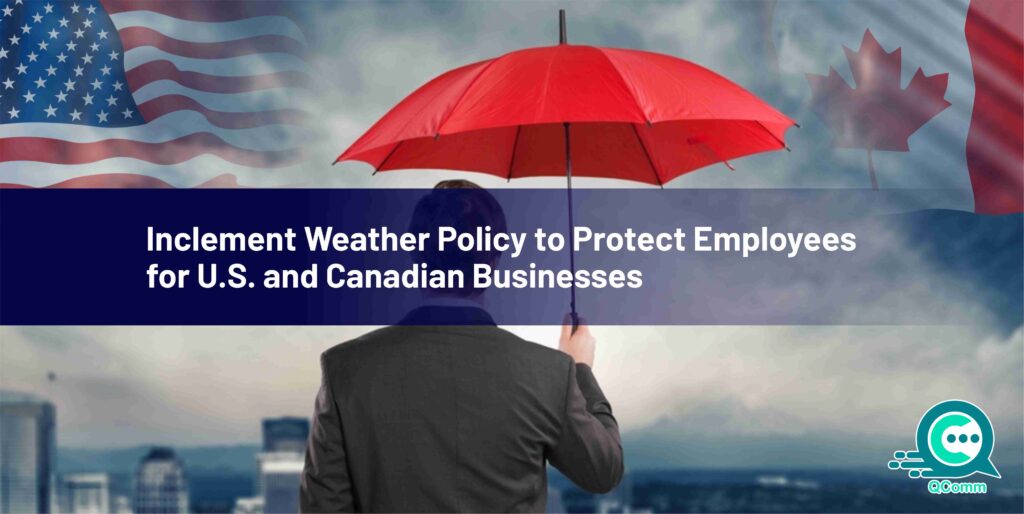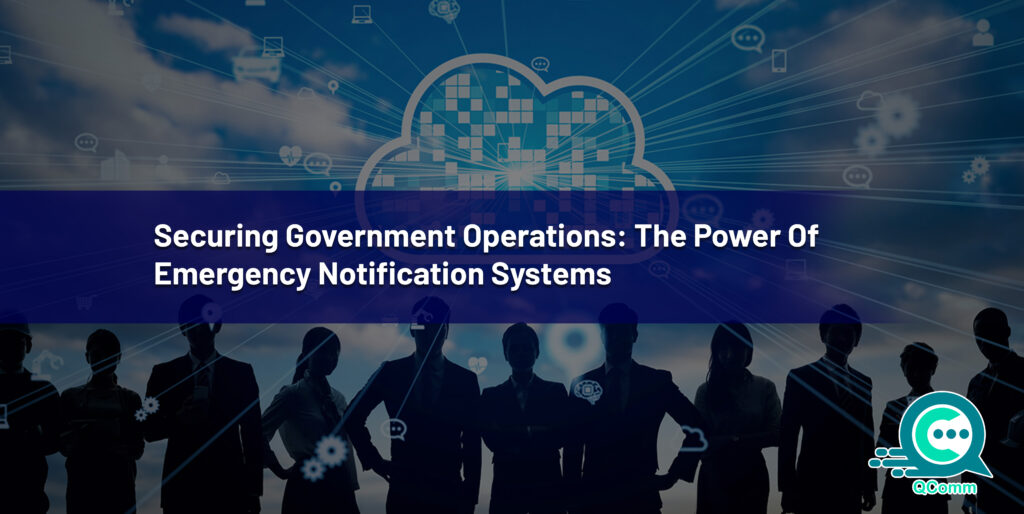
In 2023, the U.S. witnessed a record-breaking year for billion-dollar weather and climate disasters, with 28 such events causing at least $92.9 billion in damages. These figures, reported by the NOAA National Centers for Environmental Information (NCEI), highlight the increasing frequency and severity of inclement weather, including hurricanes, tornadoes, winter storms, and wildfires. The reality is that both U.S. and Canadian businesses face growing challenges due to extreme weather events. To ensure employee safety and maintain business continuity, it’s critical to have a robust inclement weather policy in place.
This blog explores the key components of an effective inclement weather policy, best communication practices, and how advanced emergency communication services can support businesses in the U.S. and Canada to stay prepared and resilient during severe weather events.
What is Inclement Weather?
Inclement weather refers to a range of severe weather conditions that can disrupt daily business operations and threaten the safety of employees. In both the U.S. and Canada, these weather conditions include:
- Hurricanes: Common along the U.S. Gulf and East Coasts, causing heavy rainfall, flooding, and wind damage.
- Wildfires: An increasing threat, particularly in the western U.S. and Canada, fueled by prolonged dry periods and rising temperatures.
- Flooding: Severe flooding often results from hurricanes or heavy rainfall, impacting coastal and inland areas.
- Tornadoes: Particularly prevalent in the central U.S. and parts of Canada, causing devastating localized damage.
- Snowstorms and Ice Storms: Frequent across northern U.S. states and much of Canada, leading to transportation disruptions and safety hazards.
Given the geographical spread and diversity of these threats, businesses need to be prepared for multiple types of inclement weather.
Importance of Having an Inclement Weather Policy
A well-designed inclement weather policy is essential for several reasons:
- Employee Safety: The foremost priority of any organization is to protect its workforce. Clear guidelines help employees understand how to stay safe before, during, and after an extreme weather event.
- Business Continuity: Weather disruptions can halt operations, leading to lost revenue and delayed services. A policy ensures that businesses can resume activities quickly by setting expectations for remote work or office closures.
- Compliance with Regulations: While OSHA (Occupational Safety and Health Administration)does not have a specific standard for working in extreme weather, businesses in the U.S. are still required to maintain a safe working environment. Similarly, Canadian businesses must adhere to workplace safety laws, making inclement weather policies an integral part of compliance.
Enhanced Resilience: With inclement weather becoming more frequent, having a policy builds organizational resilience, ensuring that employees know how to react and that business processes can continue with minimal disruption.
What to Include in an Inclement Weather Policy
A comprehensive policy should cover three primary areas:
1. Safety Procedures
Businesses must outline safety protocols specific to different types of weather events. For example:
- Evacuation Plans: Detailed evacuation routes and assembly points for hurricanes or wildfires.
- Shelter Procedures: Safe indoor locations for employees during tornado warnings or severe storms.
- Premises Security: Guidelines for securing business assets ahead of forecasted weather events.
Incorporating local weather risks is essential for making the policy effective. For instance, a business in Toronto may prioritize ice storm protocols, while one in Texas might focus on tornadoes and hurricanes.
2. Communication Guidelines
Effective communication is key before, during, and after inclement weather events. Businesses should clearly define communication channels and protocols for reaching employees in real time, such as:
- Pre-configured messages for events like tornadoes, floods, or snowstorms.
- Communication Templates: Standardized email and text templates that can be easily adapted based on the severity of the weather.
At QComm, our platform provides an all-in-one communication solution, utilizing desktop alerts, instant notifications, and even digital signage to ensure that messages are seen promptly across all devices. Unlike emails, which can be overlooked, emergency alerts override other applications, ensuring immediate visibility.
3. Employee Rights and Compensation
A good policy should address employee rights, including:
- Pay During Office Closures: Define whether employees will be compensated if severe weather forces closures.
- Remote Work Options: Offer flexible working arrangements during weather events. For example, telecommuting can help employees stay productive when travel is unsafe.
In Canada, provincial laws may vary, so businesses should ensure they adhere to local employment standards. Similarly, in the U.S., businesses must follow state regulations regarding paid leave during emergencies.
Communication Before, During, and After an Extreme Weather Event
Pre-Event Communication
Preparedness is key. Companies should send pre-configured messages to employees about potential weather threats. For example, businesses in flood-prone areas can notify employees to evacuate or prepare accordingly. Emergency preparedness training can ensure everyone knows what to do in a crisis.
During the Event
During inclement weather, it’s vital to keep employees updated in real time. Internal communication tools can send urgent messages directly to desktops or mobile devices, bypassing slow email systems. Real-time updates are crucial for coordinating evacuations or sharing shelter-in-place instructions.
Post-Event Communication
After the event, organizations should assess the effectiveness of their communication strategies. Survey employees to gather feedback on what worked and what didn’t. Regularly updating the crisis communication plan ensures the organization stays prepared for future events.
How QComm Come Into The Picture:
At QComm, we provide advanced communication tools that help businesses in the U.S. and Canada stay connected during extreme weather events:
- Real-Time Alerts: Our platform allows businesses to send emergency alerts directly to employees’ desktops, mobile phones, or digital signage screens, ensuring critical messages are received instantly, regardless of the application being used.
- Communication Templates: Pre-loaded templates for different weather events enable swift action. These can be customized for local weather conditions, whether it’s a hurricane on the Gulf Coast or a snowstorm in Montreal.
- Message Receipts: One of our most powerful features is the ability to confirm message delivery with receipts, ensuring that every employee has seen the alert. This eliminates the uncertainty of traditional email communication.
By integrating advanced emergency tools into your inclement weather policy, you can ensure timely, reliable communication with your workforce, even in the most unpredictable conditions.
Looking to the Future
As climate change intensifies, the frequency of extreme weather events will likely continue to rise. Businesses must stay proactive, continuously updating their inclement weather policies to reflect new threats and best practices. With QComm, you can ensure your organization is ready to respond swiftly to protect employees, safeguard business operations, and maintain resilience.
Conclusion
An effective inclement weather policy is critical for safeguarding employees and maintaining business continuity in the U.S. and Canada. By addressing safety protocols, communication strategies, and employee rights, businesses can mitigate the impact of severe weather events. Leveraging advanced emergency tools, real-time alerts and message receipts can further enhance your organization’s preparedness and resilience.
Subscribe to our newsletter for more insights on crisis management, and visit QComm to learn how our platform can support your business during inclement weather events.


